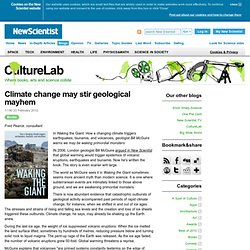

Climate change may stir geological mayhem. Fred Pearce, consultant In Waking the Giant: How a changing climate triggers earthquakes, tsunamis, and volcanoes, geologist Bill McGuire warns we may be waking primordial monsters IN 2006, London geologist Bill McGuire argued in New Scientist that global warming would trigger epidemics of volcanic eruptions, earthquakes and tsunamis.

Now he's written the book. The story is even scarier writ large. Extending Montreal Protocol (item 1) News Alert Issue 288, 15 June 2012 Science for Environment Policy About this service.

Planet may be near tipping point, study warns. STANFORD (US) — The planet may be nearing a critical threshold, beyond which environmental changes will be rapid and unpredictable, according to a new study.

Most current predictions of environmental change are based on extrapolations from current trends. But what if that isn’t an accurate picture of the future? What if we are approaching a critical threshold—one that, once crossed, would lead to accelerated, widespread and largely unpredictable environmental degradations? This is the alarming conclusion of a paper co-authored by Stanford University biology professor Elizabeth Hadly that appears in the new issue of Nature—an issue devoted to the environment, in anticipation of the United Nations’ June 20-22 Conference on Sustainable Development.
The consensus statement by 22 respected scientists uses past examples to suggest that Earth’s current systems will experience a major disruption—perhaps within a few generations. Extinction’s toll could rival climate change. MCGILL (CAN) — Loss of biodiversity appears to affect ecosystems as much as climate change, pollution, and other major forms of environmental stress.

A new study published in the journal Nature directly compares the effects of biological diversity loss to the anticipated effects of a host of other human-caused environmental changes—and highlights the need for stronger local, national, and international efforts to protect biodiversity and the benefits it provides. “Some people have assumed that the effects of biodiversity loss are relatively minor compared to that of other environmental stressors,” says lead author biologist David Hooper of Western Washington University.
“Our new results show that future loss of species has the potential to affect plant production just as much as global warming and pollution.” Lab-in-a-box predicts coral reef future. STANFORD (US) / U.

QUEENSLAND (AUS) — Scientists have built a small lab-in-a-box in Australia’s Great Barrier Reef to mimic the composition of the ocean as affected by climate change. Inside the mini-lab, set in shallow water 2 to 6 feet deep, elevated levels of water acidity were created to test the reaction of a few local corals. (Other corals in the vicinity were not adversely affected.)
The international team includes Jeff Koseff, Rob Dunbar, and Steve Monismith, senior fellows of Stanford University’s Woods Institute for the Environment. The potential loss is tremendous: reefs provide aquaculture, protein, and storm protection for about 1 billion people worldwide. Trade and biodiversity loss. If you think of international trade and endangered species you most probably think of illegal trade of products made from wild animals and plants (e.g. ivory, leather, rhino horns).

Although illegal trade is undoubtedly a significant threat to biodiversity, international trade affects wild species in a more complex way. A new study in Nature is the first to quantify the impacts of global trade on animals. The researchers looked at 7,000 threatened animal species from the International Union for Conservation of Nature Red List and linked them to more than 15,000 commodities produced in 187 countries (e.g. tea, coffee, palm oil).
They discovered that 30% of the species threats are due to international trade. The study also points out countries that contribute the most to biodiversity loss through trade. Natural land a welcome mat for ladybugs. MICHIGAN STATE (US) — Having large tracts of natural habitat around crop fields invites pest-gobbling ladybugs, which could save farmers an estimated $4.6 billion a year on insecticides.

Non-crop plants provide ladybugs and other predatory insects with food and shelter, helping them to survive and thrive in areas where they are needed. In an attempt to increase benefits from predatory insects, researchers have often planted strips of flowers along the edges of crop fields. However, natural habitats also provide vital food and shelter resources, and may be more important for pest control, says Megan Woltz, a doctoral student at Michigan State University and co-author of a study that appears in the current issue of Agriculture, Ecosystems and Environment.
Having the right blend of "personalities" can impact the survival of the animal group. Wind-churned plastics litter deep ocean. U.

WASHINGTON (US) — By skimming only the surface, decades of research into how much plastic litters the ocean may vastly underestimate the true amount of debris in some cases, new findings show. While working on a research sailboat gliding over glassy seas in the Pacific Ocean, oceanographer Giora Proskurowski, a researcher at the University of Washington, noticed something new: The water was littered with confetti-size pieces of plastic debris, until the moment the wind picked up and most of the particles disappeared. After taking samples of water at a depth of 16 feet (5 meters), Proskurowski discovered that wind was pushing the lightweight plastic particles below the surface. Proskurowski gathered data on a 2010 North Atlantic expedition where he and his team collected samples at the surface, plus an additional three or four depths down as far as 100 feet.
(Credit: Sea Education Association) The return of heritage fruit and veg varieties. 3 May 2012Last updated at 03:20 ET By Hannah Briggs & Matt Bardo BBC Gardening and BBC Food.

In Hawaii, 40-square-miles and many tough choices. STANFORD (US) — After a two-year effort, researchers and Hawaii’s largest landholder have mapped the ecological future of a large chunk of Oahu.

In the end, the environmental value of the land—not just the commercial value—was considered. A former sugar plantation, the abandoned farmland is owned by the Kamehameha Schools trust. Integrating ecosystem-service tradeoffs into land-use decisions. Author Affiliations. Biodiversity loss leaving us high and dry. MCGILL (CAN) / U. MICHIGAN (US) — The loss of biodiversity is increasingly threatening Earth’s ability to provide humans with goods and services like food, water, fertile soils, and protection from pests and disease, a 20-year review shows.
Presented in the June 7 edition of Nature, the scientific consensus statement summarizes evidence that has emerged from more than 1,000 ecological studies conducted since the 1992 Earth Summit in Rio de Janeiro, Brazil. “We believe that ongoing loss of biological diversity is diminishing the ability of ecosystems to sustain human societies,” says Andrew Gonzalez, associate professor of biology and the Quebec Centre for Biodiversity Science at McGill University and author on the paper. Birds trail climate in north-bound shift. Black vultures have spread northward in the last 35 years and now winter as far north as Massachusetts, where the minimum winter temperature is similar to what it was in Maryland in 1975. (Credit: Cornell University) As warmer winter temperatures become more common, one way for some animals to adjust is to shift their ranges northward. But a new study of 59 North American bird species indicates that doing so is not easy or quick—it took about 35 years for many birds to move far enough north for winter temperatures to match where they historically lived.
Climate-Smart Agriculture. Pine forests threatened by the invasion of giant moths - News. Google imagines environment-aware mobile adverts. Update for world temperature data. 19 March 2012Last updated at 12:37 ET By Mark Kinver Environment reporter, BBC News. 'Humans killed off Australia's giant beasts' 24 March 2012Last updated at 10:16 GMT. Climate 'tech fixes' urged for Arctic methane. UK carbon measuring centre 'to improve climate future' 25 March 2012Last updated at 20:05 ET By Richard Black Environment correspondent, BBC News. Temperatures could rise by 3C by 2050, models suggest. 25 March 2012Last updated at 13:41 ET Climate temperature predictions can influence planning, such as for sea defences.